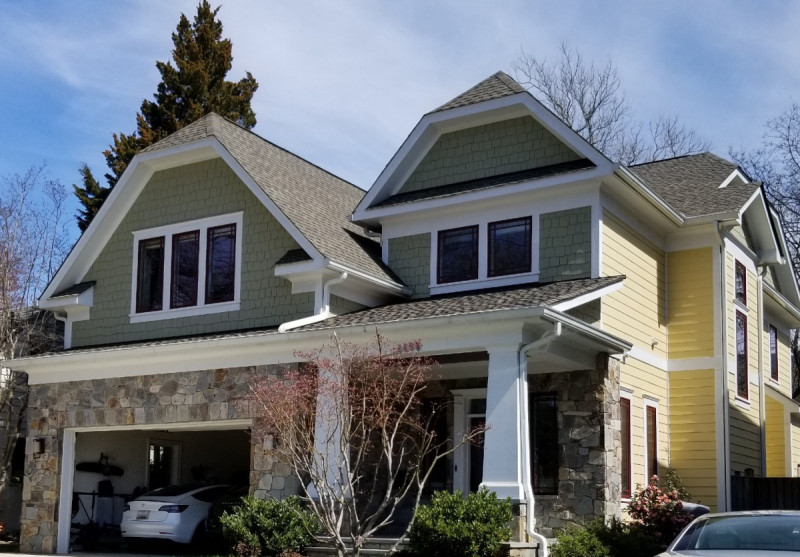How one house explains zoning in Montgomery County

Though this home on Leland Street has gone through many iterations, it still remains a single-family home
The history of Montgomery County zoning can be told in one house.
The story starts in the 1930s, a few years after Montgomery County adopted its first zoning ordinance. A developer named George Sacks began to build on a large tract of land he owned just south of downtown Bethesda.
Expensive subdivisions like Kenwood and Chevy Chase West had already succeeded nearby. But Sacks’s land was by the railroad tracks, not a place where the wealthy wanted to live in the age of coal-burning steam engines. So he built more modestly, with prices starting at $7,130.
In those days, theWashington Postran regular promotions of what they called “Washington Post model homes.” One of Sacks’ houses, a 1445-square-foot Cape Cod on Leland Street, was selected.

An image of one of developers George Sacks's houses on Leland Street, featured as a Washington Post model home.
The development’s upscale Chevy Chase location was a big selling point, and the Post laid it on. Here’s how they described Sacks’s subdivision in their write-up:
“In the center of a fertile tract of gently rolling ground, bordered by cool woods and handsome estates, this neighborhood traversed by broad driveways has a delightful atmosphere of rural remoteness, but is almost around the corner from the growing metropolitan area of Bethesda, with its schools, churches, stores and every urban convenience….”
And there’s more:
“Surrounded by high-priced properties andrestricted communities, its charms and exclusive appeal are perpetually assured.”
The meaning of “restricted communities” in that day was very clear. It meant that written into the deed to the property was what is called a “covenant.” The covenant limited who could live there – by making the houses too expensive for most people to afford, through restrictions on race and ethnicity, and most often with both.
As things turned out, Sacks didn’t sell very many of these houses. So in 1941, he asked the county to rezone the rest of his property for apartments.
The rezoning was controversial. Civic groups opposed it at a series of public hearings. Leading the criticism was the Montgomery County Civic Federation. Just before this, Civic Fed had taken a stand opposing the construction of any more apartments anywhere in the metropolitan area.
最喜欢的县委员投票三比一or of Sacks. (Baseball fans will want to know that Walter Johnson, then a Montgomery commissioner, voted yes.) The opponents persisted, and soon a lawsuit to overturn the vote was filed. The name of the plaintiff tells its own story: Robert E. Lee Wiltberger.
That lawsuit failed, and Sacks was able to build apartments. The rest of his property, down to the park where the Bethesda pool now sits, gradually filled up with three-, four-, and five-story buildings.
Fast forward sixty years, to the start of the 2000s. Apartments and townhouses stood south of Bradley Boulevard. But sandwiched between the older apartments and the high-rises sprouting in downtown Bethesda remained a small area of single-family houses, among them the old model home on Leland Street. That little area, by now known as the Sacks Neighborhood, was still zoned single-family.
The residents of the Sacks Neighborhood saw the money being made around them, and they didn’t want to be left out. In 2004, they organized to sell all their houses in a package for dense development. After three years of research and meetings with four developers, they reached a deal with a firm called Monument Realty. The offer on the table was three million dollars for each house if the area could be rezoned for high-rises.
They faced a big obstacle: neighborhood associations elsewhere in Chevy Chase opposed the rezoning. And they had an ally in Nancy Floreen, a county council member known as a supporter of real estate development elsewhere in the county. High-rises were soon out of the question, and Monument cut its offer to two million. Thirty-nine of the 60 homeowners still wanted to sell.
But the opponents had the political upper hand. In February 2008 the deal fell through. Dreams of cashing out for two or three million were gone, and two years later the Leland Street model home sold for $855,000.
The buyers tore down the 1445-square foot house and built themselves a 5314-square-foot McMansion. Redfin recently valued it at $2.3 million. That structure, located just 1200 feet from the Purple Line and Red Line station entrances now under construction, is occupied by a single family of four.

The old Sacks house was sold, demolished, and replaced with a much bigger single family home.
Nationally and in Montgomery County, residential segregation by race has dwindled over the last half-century while separation by income has increased. As it happens, the owners of the Leland Street house today are people who racial covenants would have excluded from most Chevy Chase neighborhoods in 1935.
But as this history illustrates, exclusion by race and exclusion by income have always been intertwined. Because of a zoning ordinance written in the 1920s, only one family can live in the 5314-square-foot building on Leland Street – the same as in the structure one-quarter its size that was built in 1935.
The legacy of one hundred years of separation lives on in that house.
This article is based on a presentation at the April 21 conference on “Connecting the Corridor: Lessons from a Century of Racism and Resilience Along the Purple Line.”Click hereto see the entire presentation.
